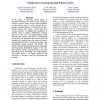Free Online Productivity Tools
i2Speak
i2Symbol
i2OCR
iTex2Img
iWeb2Print
iWeb2Shot
i2Type
iPdf2Split
iPdf2Merge
i2Bopomofo
i2Arabic
i2Style
i2Image
i2PDF
iLatex2Rtf
Sci2ools
HICSS
2011
IEEE
2011
IEEE
Collaborative Learning through Wireless Grids
In this paper, we describe wireless grids, an emerging technology that enables ad hoc sharing of resources (such as screen, services and microphone) on edge devices (such as mobile Internet devices, laptops and mobile phones). As wireless devices have become common, and “smart,” wireless grids have become practical. To highlight the capabilities of wireless grids to support collaborative learning, projects at the K-12 and undergraduate levels illustrate that wireless grid theory is transitioning into practice. We hypothesize that wireless grids can transform how students learn, the content of courses, learning-related practices, classroom dynamics and relationships among students and faculty. The authors conclude that applications of this technology will bring about fundamental changes in the ways that students, schools and universities create and disseminate ideas, knowledge, and understanding. The mobile phone is no longer banned in the classroom; it becomes a tool for instructi...
| Added | 20 Aug 2011 |
| Updated | 20 Aug 2011 |
| Type | Journal |
| Year | 2011 |
| Where | HICSS |
| Authors | Angela Usha Ramnarine-Rieks, Lee W. McKnight, Ruth V. Small |
Comments (0)

